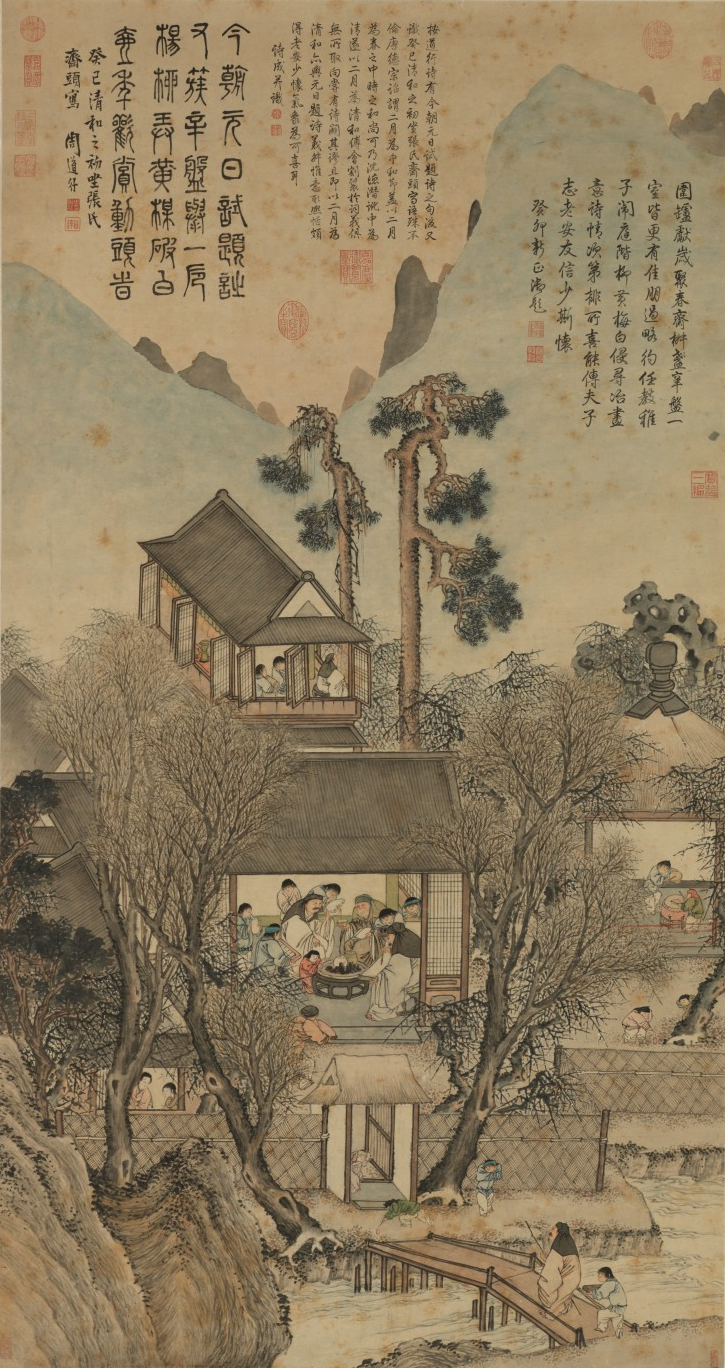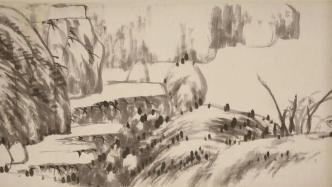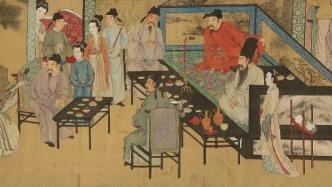
What was life like in ancient China? Perhaps we can get a glimpse of it from the pictures of green mountains and rivers and bustling markets that have been handed down in China for thousands of years. Recently, the original calligraphy and painting exhibition "Taste of the World is Joy - Scenes of Life in Ming and Qing Paintings", which brings together many precious collections from the Tianjin Museum and the China Three Gorges Museum in Chongqing, opened at the China Three Gorges Museum in Chongqing.
The exhibition uses "ancient life" represented in paintings as the entry point to show the life scenes, life taste and life interests of ancient Chinese people. Among the exhibits, Dong Qichang, Chen Hongshou, Shi Tao, Shen Zhou, Wen Zhengming, Tang Yin, Yun Shouping all appeared. The famous Qing Dynasty paintings "Wanhu Chaotian Scroll" collected by the Tianjin Museum, the Ming Dynasty Wen Zhengming's "Linxie Jiancha Scroll", and the Ming Dynasty Tang Yin's "Han Xizai's Night Banquet" collected by the China Three Gorges Museum in Chongqing are also rare exhibitions.
According to the organizer, a total of 60 pieces/sets of calligraphy and painting works will be displayed in this exhibition, which are divided into "This is my hometown where I feel at ease" (customs and customs), "A coop in the mist and rain for a lifetime" (literati and elegant affairs), "A century of knowledge of people and affairs" The three units "Several Changes" (vicissitudes of world affairs) present to the audience all aspects of people's lives during the Ming and Qing Dynasties: festivals, entertainment and leisure, material production and life...from the folk to the court.
The curator of this exhibition, Wang Qiyue from the Display and Exhibition Department of China Three Gorges Museum in Chongqing, told The Paper that this exhibition is an original exhibition jointly curated by China Three Gorges Museum in Chongqing and Tianjin Museum. In addition to bringing together many masterpieces by famous artists, the curatorial ideas are also different from past. “In the past, some of the ancient painting exhibitions we held either divided the exhibition themes from different painting categories such as figures, flowers, birds, and landscapes, or focused on narratives from the history of painting development or painting schools, and rarely started from the story of the painting itself. "Wang Qiyue said, "I think it is interesting to explore the story content of the paintings themselves, and it can also bring the audience closer to the cultural relics. Therefore, this exhibition started from the storytelling of the paintings, from three perspectives: folk, literati, and court. Cut in to show the ancient customs, literati and the changes in palace life."

exhibition site
Wang Qiyue introduced that the Tianjin Museum and the China Three Gorges Museum in Chongqing are both museums known for their calligraphy and painting collections, and their calligraphy and painting collections are relatively famous among museums across the country. The paintings in the China Three Gorges Museum in Chongqing are mainly works by famous landscape, figure, flower and bird paintings since the Song Dynasty, especially from the Ming and Qing Dynasties to the Republic of China. The works include not only local famous artists from Sichuan and Chongqing, but also from the north and the south, and are inclusive. The Tianjin Museum's collection of paintings is comprehensive, with rich themes and diverse forms. It is rich and sophisticated, and there are also rare and rare domestically handed down works. This exhibition is jointly curated on the basis of fully tapping the painting resources of the two museums. .
The exhibition displays a total of 60 pieces/sets of paintings, including 37 sets from Tianjin Museum and 23 sets from Chongqing Three Gorges Museum, covering Dong Qichang, Chen Hongshou, Shi Tao, Shen Zhou, Wen Zhengming, Tang Yin, Yun Shouping, Lan Ying, Huang Shen, Hua Yan, etc. Masterpieces. Among them, the anonymous "Wanhu Chaotian Picture Scroll" from the Qing Dynasty collected by Tianjin Museum is exhibited for the first time in a domestic museum other than Tianjin. This work was carefully designed by Sun Fanyao, a descendant of Fan Zhongyan, to commemorate Qianlong's six visits to the south of the Yangtze River and his four visits to Mount Tianping. The painting reproduces the mountain scenery, market customs and grand welcome scene in the west area of Suzhou when Qianlong visited the south.
The "Han Xizai Night Banquet" collected by Tang Yin from the Ming Dynasty and collected by the China Three Gorges Museum in Chongqing is also rarely on display. "Han Xizai's Night Banquet" is a famous painting collected by the Palace Museum. It was originally painted by Gu Hongzhong during the Five Dynasties period and is now a copy of the Song Dynasty. This painting details the family banquets of the upper class during the Five Dynasties and Ten Kingdoms period and the Southern Tang Dynasty. The "Han Xizai Night Banquet" exhibited at the China Three Gorges Museum in Chongqing was copied by Tang Yin of the Ming Dynasty.

Ming Tang Yin's "Han Xizai's Night Banquet" (detail)
"This "Han Xizai Night Banquet" is also one of the top ten treasures of our museum voted by the audience. In the more than ten years since I have been working, I remember it has been exhibited twice, and this is the third time. Because it It is a copy of the Ming Dynasty, and is not exactly the same as the Song copy of the Forbidden City in content. Tang Yin recreated it in the copy, and incorporated the Ming Dynasty Suzhou area literati's decorative layout of garden room art and the landscapes of the Wumen School into the painting. Artistic style." Wang Qiyue said.
Appreciation of exhibits:
Unit 1 "This place of peace of mind is my hometown"

"Along the River During Qingming Festival" Qiu Ying, Ming Dynasty (Part) Collection of Tianjin Museum (Part)

"Along the River During Qingming Festival" Qiu Ying, Ming Dynasty (Part) Collection of Tianjin Museum (Part)

"Along the River During Qingming Festival" Qiu Ying, Ming Dynasty (Part) Collection of Tianjin Museum (Part)

"Along the River During Qingming Festival" Qiu Ying, Ming Dynasty (Part) Collection of Tianjin Museum (Part)

"Along the River During Qingming Festival" Qiu Ying, Ming Dynasty (Part) Collection of Tianjin Museum (Part)
Zhang Zeduan's "Along the River During the Qingming Festival" depicts the prosperity of Bianjing, the capital of the Northern Song Dynasty, as well as the natural scenery, folk customs, market life, etc. on both sides of the Bianhe River. It is an important material for later generations to study the political economy, history and culture of the Song Dynasty.
"Along the River During the Qingming Festival" by Qiu Ying, a painter of the Ming Dynasty, depicts the streets, shops, urban construction, inside and outside the palace, folk customs and other urban features of Suzhou in the Ming Dynasty. There are more than 2,000 characters in the painting, which intuitively reflects the folk customs of Suzhou in the Ming Dynasty.
The signature "Qiu Ying" at the end of this painting is actually a "Suzhou picture" made in Qiu Ying's name, which is a commercial painting made by a folk workshop. However, its artistic level is high and it can be regarded as a masterpiece among Ming Dynasty paintings. The scroll unfolds slowly from the suburbs, inside the city to outside the city. It has a full composition and well-drawn content. It covers all aspects of production, life, entertainment and leisure, etc., and is of great significance to the study of urban development and folk culture.

"Sui Dynasty Picture Scroll" Ming Zhou Daoxing Collection of Tianjin Museum
Zhou Daoxing, whose birth and death dates are unknown, was named Boda. He was famous for his paintings during Wanli (1573-1620). A native of Wuxian County (now Suzhou, Jiangsu Province). Good at landscapes and characters.
Emperor Qianlong 's inscription on the painting reads: "We gather around the fire to celebrate the New Year and gather for the Spring Festival, with peppers, lamps and hot plates all over the room. There are also friends who have passed by, teaching young children to make noise in the courtyard. Willows, yellow plums and white flowers invade Xunye, and the poetic meaning of the painting is arranged in sequence. I am happy to be able to pass on my master's ambitions, and I am grateful to you for being a good friend. Guimao (1783), the new imperial title."
Seals: "Treasure of the Emperor of Ancient Xi" in Zhu Wen, "Yu Ri Zizi" in White, "Jia Qing Yu Lan's Treasure" Zhu Wen Seal, "Xuan Tong Yu Lan's Treasure" Zhu Wen Seal, "Qianlong Appreciation" white inscription, "Jia Qing Appreciation" "Zhu Wen Yin," San Xi Tang Jing Jian Xi" Zhu Wen Yin, "Yi Zi Sun" Bai Wen Yin and other palace collection seals.
"Sui Chao" means "Sui Dan", which generally refers to the first day of the first lunar month. "Qing Jia Lu" records: "In the New Year's Day, three blasts of firecrackers are fired when the door is opened to ward off epidemic diseases, which is called opening the door to firecrackers." , meaning to celebrate the New Year happily. In the picture, the family in the main house, old and young, watch the New Year's Eve around the stove, and the charcoal fire is burning, which also confirms the content recorded in the literature.
Paintings with the theme of "Sui Dynasty" involve figures, flowers and birds, etc. The floral patterns mostly include plum blossoms, narcissus, Ganoderma lucidum and other plants in the vase; persimmons, pomegranates, bergamot and other auspicious fruits are placed on the table, which is called "Sui Chao Qing Gong". Figure paintings mostly express folk customs, family reunions, happiness and peace. These works provide us with rich information for researching historical festivals and folk customs.
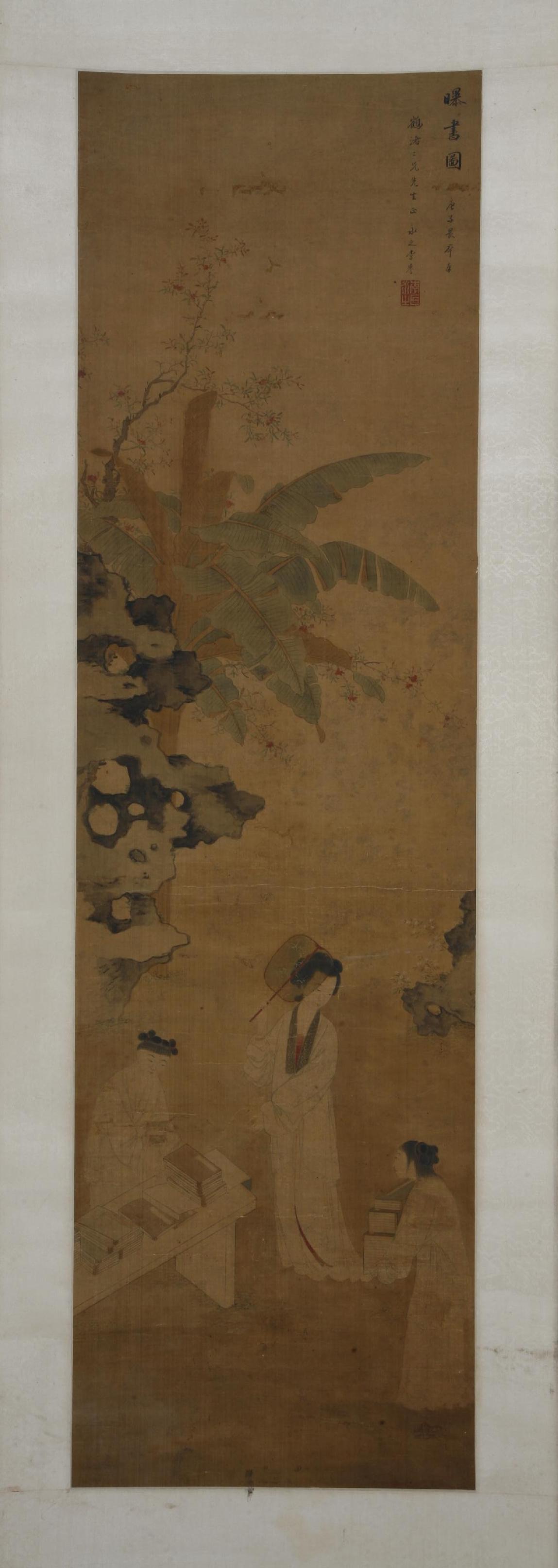
"Exposed Book and Picture Scroll" collected by Li Yu, Tianjin Museum
Li Yu, whose birth and death dates are unknown, was named Yongzhi, and was born in Dantu (now Zhenjiang, Jiangsu Province). He was famous for his work on landscapes and flowers in his early years, but his career declined in his later years. He died in Natural Temple in Jiaoshan.
Exposing books is an important method for ancient Chinese book collectors to preserve books. Exposing books can achieve the effects of dehumidification and insect control.
Cui Shi [shí] of the Eastern Han Dynasty recorded in the "Four People's Monthly Order": "On July 7, the scriptures and clothes are not beetle [dù], which is the custom." Jia Sixie clearly pointed out in "Qi Min Yao Shu" that exposure "When it is necessary to write a book on a sunny day, I will expose it in a cool place under the big house, where the sun is not visible." Exposing books is not only a means of protecting calligraphy and paintings, but also a social activity. It is an opportunity for book collection institutions or private collectors to display their collections and cultural tastes, and it is also a gathering for literati and writers to communicate with each other and learn from each other. When the Royal Library of the Song Dynasty published books, all books were open to literati, similar to a book fair.
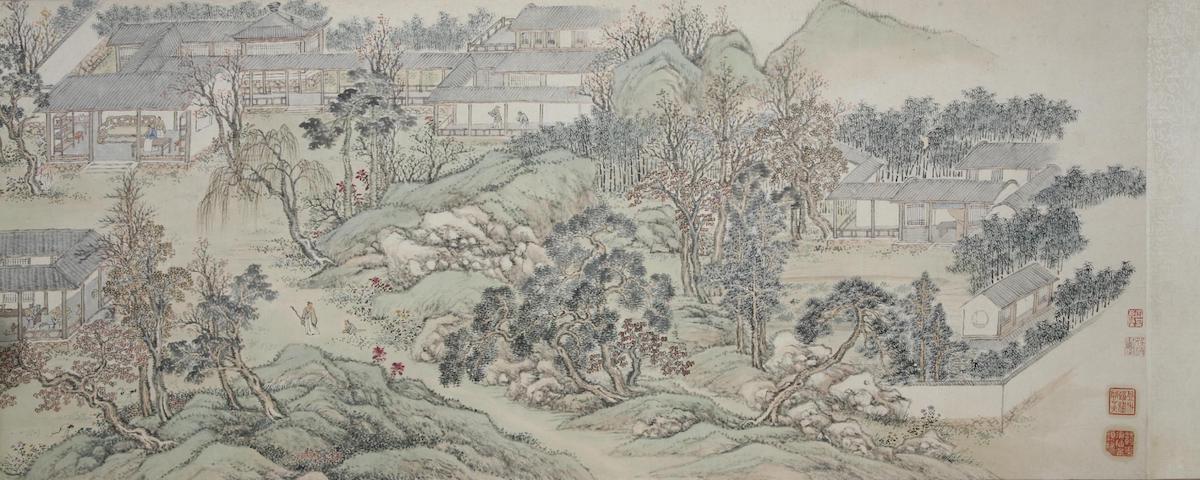
"Double Ninth Festival Picture Scroll" Yunxi Tianjin Museum Collection of the Qing Dynasty (partial part)
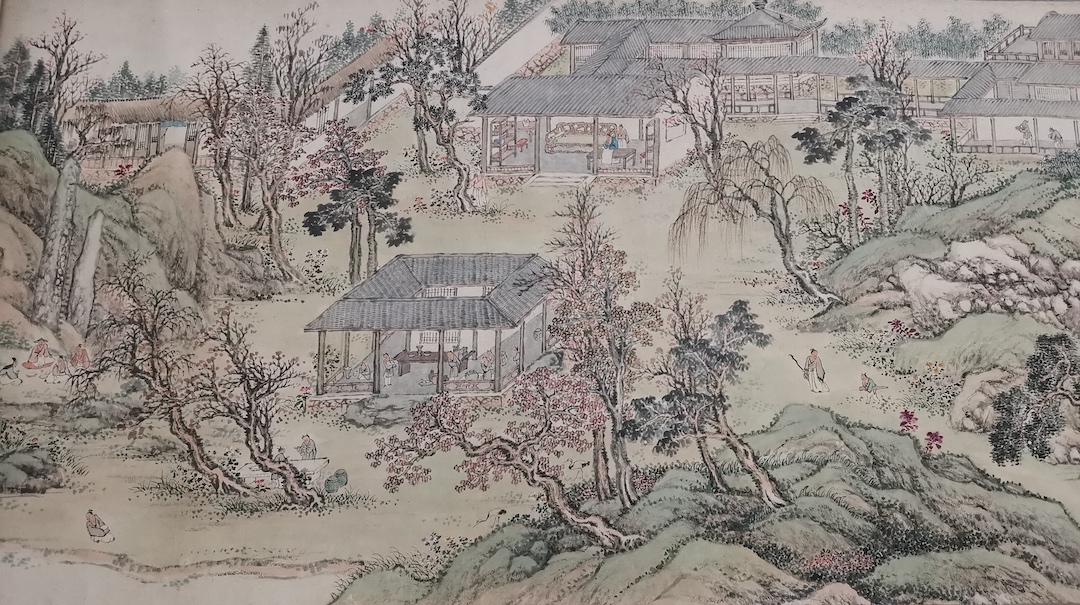
"Double Ninth Festival Picture Scroll" Yunxi Tianjin Museum Collection of the Qing Dynasty (partial part)
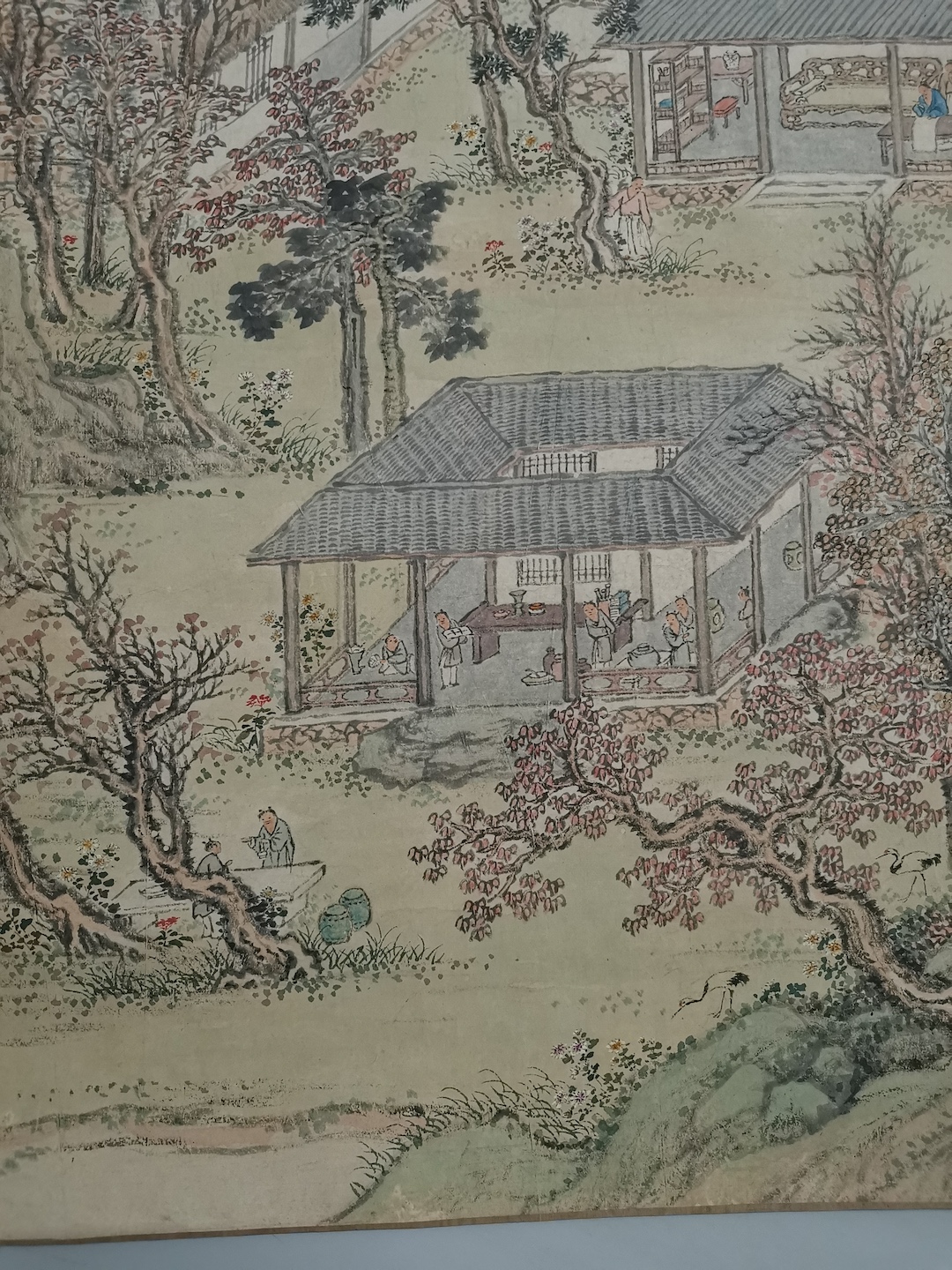
"Double Ninth Festival Picture Scroll" Yunxi Tianjin Museum Collection of the Qing Dynasty (partial part)
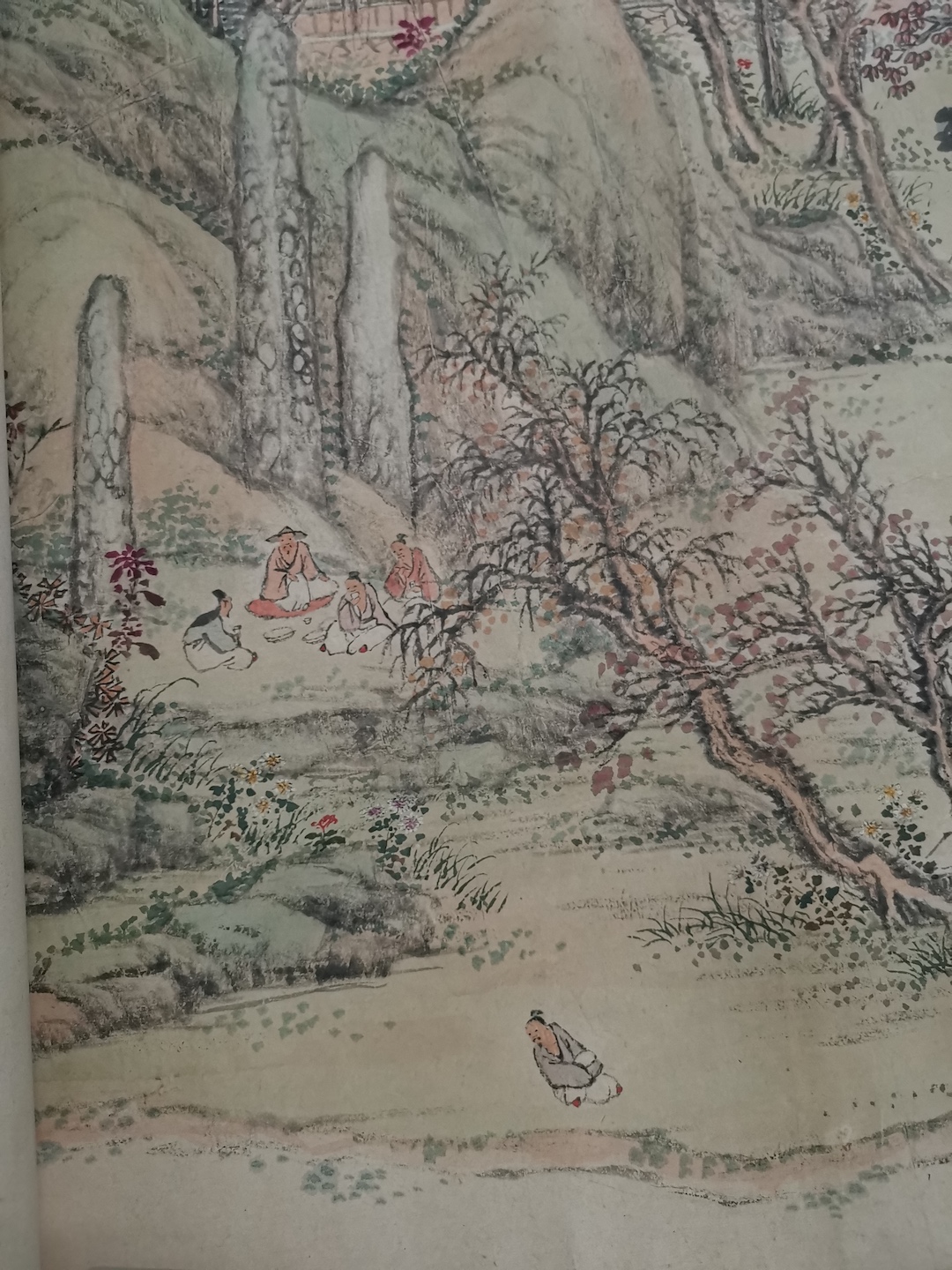
"Double Ninth Festival Picture Scroll" Yunxi Tianjin Museum Collection of the Qing Dynasty (partial part)
Yunxi (? - 1758), the twenty-first son of Emperor Kangxi Aixinjueluo Xuanye, posthumously named Jing. The courtesy name is Qianzhai, the nickname is Ziqiong, and the other names are Ziqiongya Taoist and Chunfu layman. Good at calligraphy and painting. The landscape brushwork is elegant and the painting style is light, which is attributed to Ni Zan.
The Double Ninth Festival, which falls on the ninth day of the ninth lunar month every year, is a traditional Chinese festival. "Double Ninth Festival" is named after the "Yang Yao is nine" in the ancient book "The Book of Changes". On the ninth day of the ninth lunar month, both the sun and the moon coincide with the ninth day, which means "the two nines overlap", so it is called "Double Nine". At the same time, the two yang numbers are combined together, so it is called "Double Ninth Festival". Ninety-Nine Returns to True Truth and One Yuan Begins. The ancients believed that the Double Ninth Festival was an auspicious day. The customs and activities of the Double Ninth Festival were first seen in the "Ji Qiu Ji" in "Lu's Spring and Autumn Annals": "(In September), the family steward is ordered to prepare for the harvest, and five important things are mentioned. The imperial records are collected in the Shencang, and they must be respected and ordered. On this day, the great emperor sacrifices himself and reports it to the emperor." This formed the activities of worshiping the emperor and ancestors on September 9th. On this day, people also hold activities such as releasing paper kites, wearing Zhuyu, drinking chrysanthemum wine, and climbing high to overlook the distance.
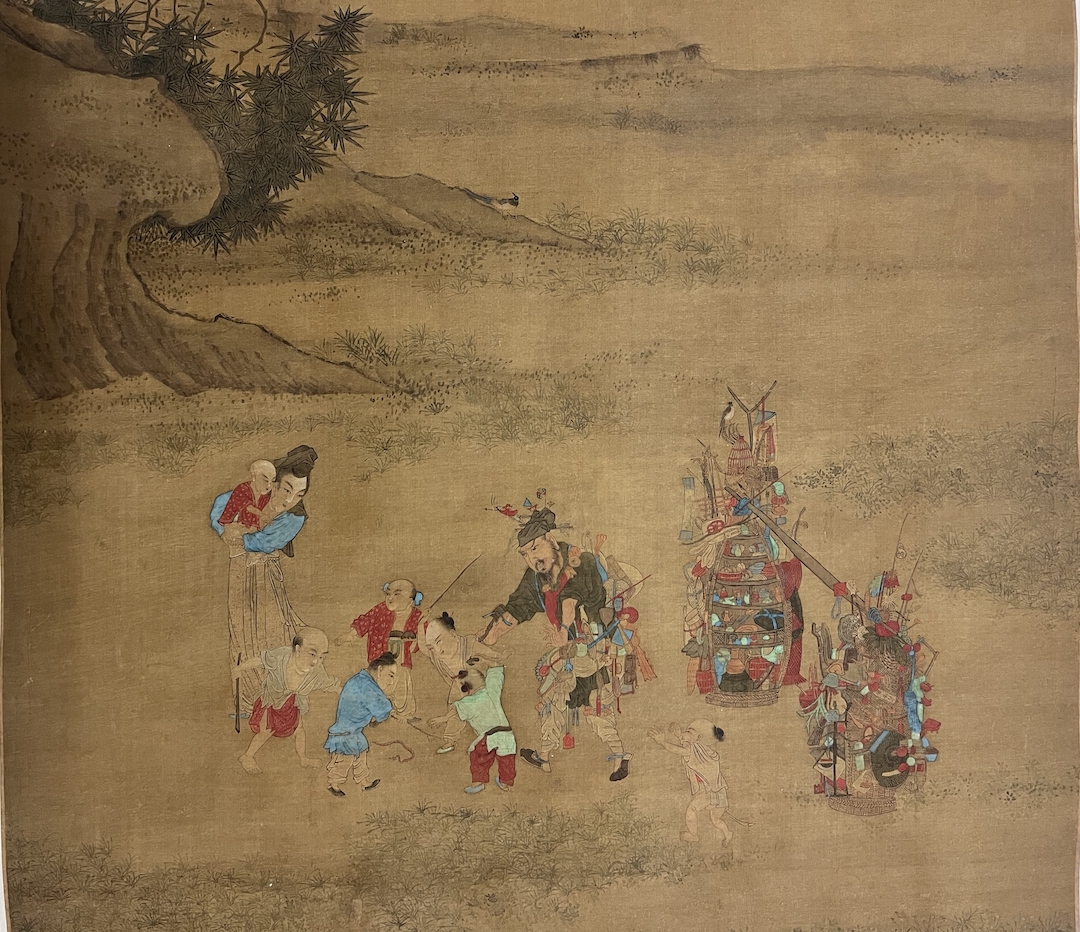
"Scroll of Merchant", Qing Dynasty, no inscription, collected by Tianjin Museum
Paintings with the theme of salesmen first appeared in the Northern Song Dynasty. During the Song Dynasty, the economy was prosperous and the people's livelihood was prosperous. Commodity trading became an important way to promote economic development. The salesmen who walked the streets played an important role in promoting the commodity economy. The daily groceries carried by the sellers such as needles, thread, rouge, gouache, and children's toys not only meet the daily needs of the people, but also bring people the joy of shopping, viewing, and all kinds of novel experiences. The custom of peddlers walking through the streets carrying burdens still existed in rural areas until the 1970s.
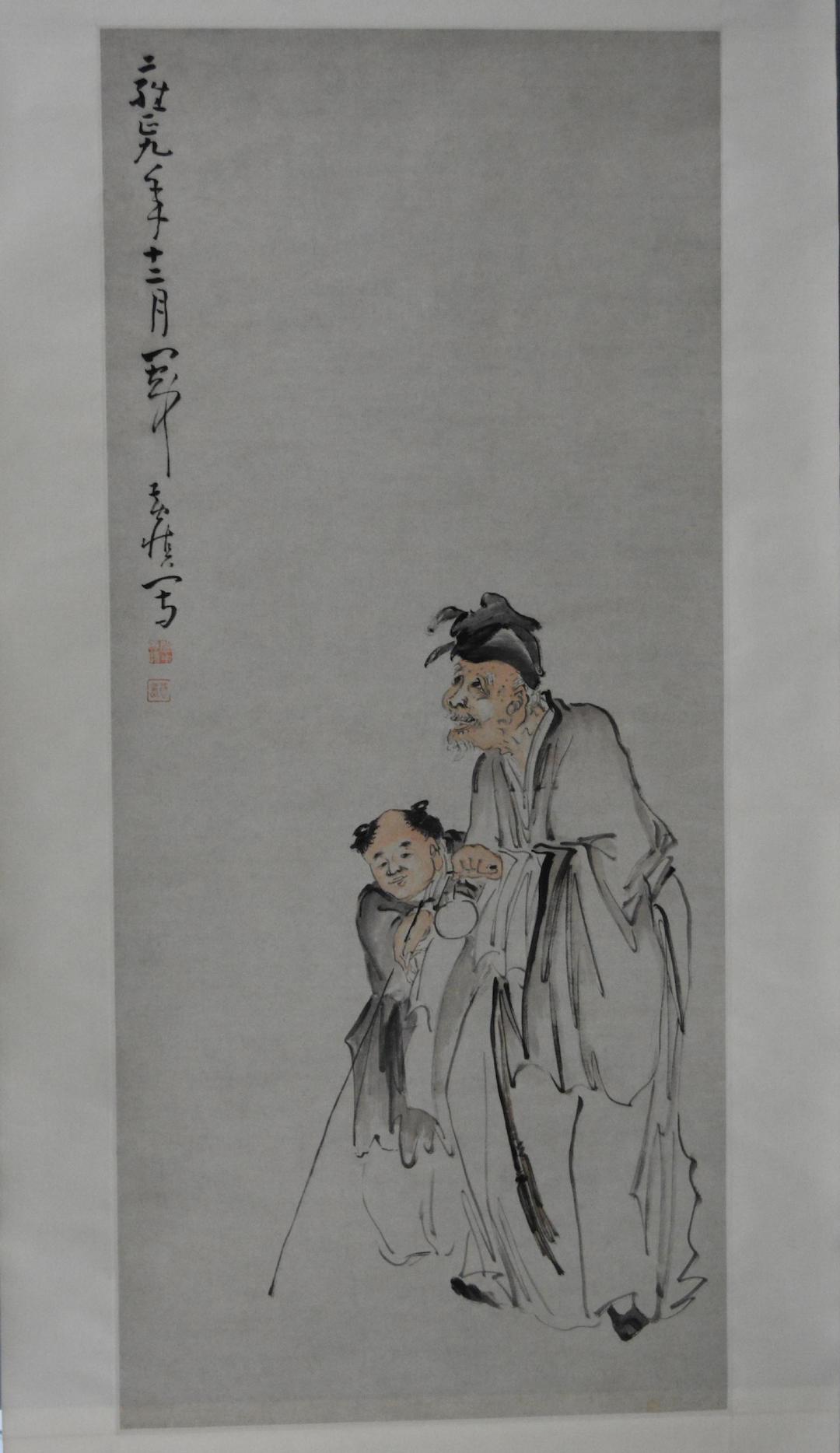
"Scroll of the Blind Old Man" collected by Huang Shen, Qing Dynasty, Tianjin Museum
Huang Shen (1687-1772), who was famous at first, had the courtesy names Gongshou and Gongmao, nicknamed Yinglaozi, Donghai Buyi, etc. He was a native of Ninghua, Fujian, and one of the Eight Eccentrics of Yangzhou. His family was poor, so he studied painting and was good at figures, landscapes, flowers and birds.
Blind paintings are a very niche and special category of figure paintings. Most of the paintings we see now show blind people fighting, playing musical instruments, etc. Painters' paintings of blind people have vivid and energetic facial expressions, whether they are playing or playing. , or setting up a stall to tell fortunes, they all have their own way of happiness and getting along, and physical disabilities and hardships in life are not enough to defeat them. They are part of all living beings, and their joys, sorrows, and joys are also part of the lives of ordinary people.
This picture was made when the artist was 45 years old. It uses a large amount of white space as a close-up of the characters. The brush strokes are free and easy, the clothes have many square folds, the facial expressions are delicately outlined, and the light ocher color is slightly applied. The transition between light and dark is natural and three-dimensional.
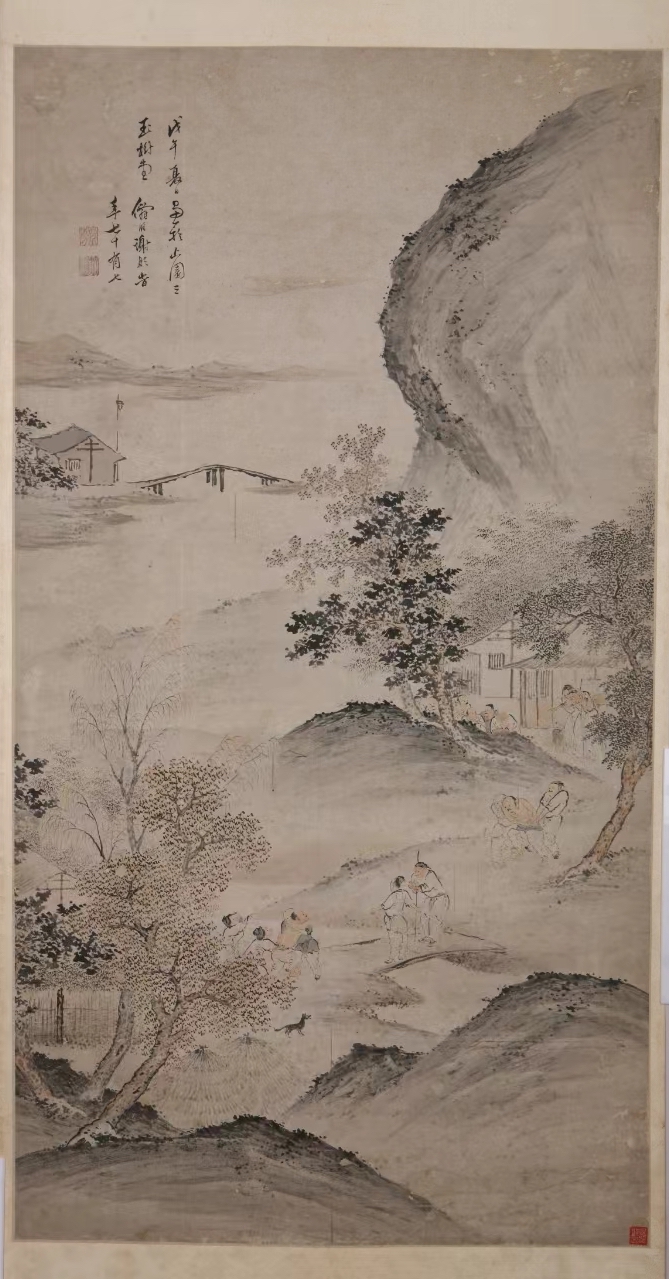
"Scroll of Village Fighting" by Xie Bin, Qing Dynasty, collected by China Three Gorges Museum, Chongqing
Xie Bin (1601-1681) was a painter in the late Ming Dynasty and early Qing Dynasty. His first name was Wenhou, and his nickname was Xianhui. He was from Shangyu (now Zhejiang), and later lived in Qiantang (now Hangzhou) with his father. Work photo.
There are times when even a small village is not peaceful. No, there is a fight! At the center of the conflict, two shirtless men were being dragged hard by someone, and they were yelling at each other across a small bridge. If there were no others pulling them, they would probably rush forward and continue tearing apart. An old man holding a staff stood in the center of the bridge, waving his hands to discourage the conflict from escalating again. At both ends of the bridge, there were people stretching their heads behind the big trees to watch the battle, and a puppy was barking at the side, seeming to be helping out. What a vivid and interesting folk custom painting.
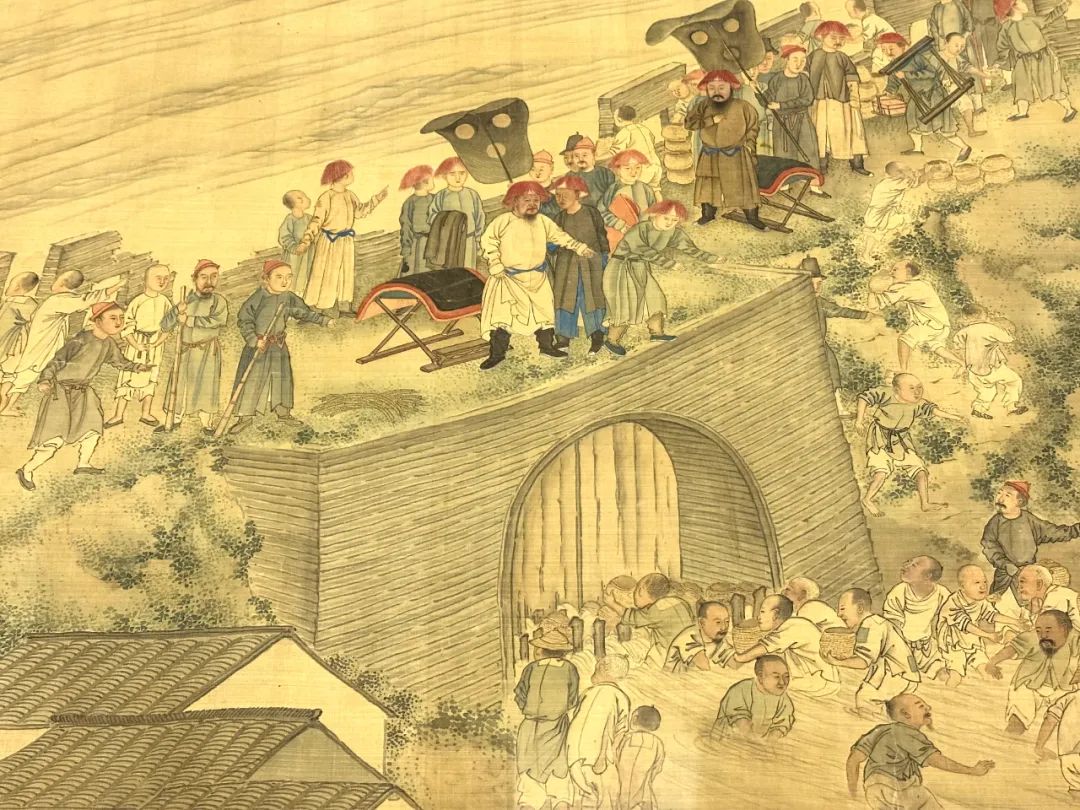
"Flood Disaster Picture Scroll" collected by Zhang Lie and Xie Pu, Qing Dynasty, Tianjin Museum

"Flood Disaster Picture Scroll" collected by Zhang Lie and Xie Pu, Qing Dynasty, Tianjin Museum
This picture was jointly painted by Xie Pu (alias Chuyu) and Zhang Lie (alias Youpu) of Wulin in the Jiashen period of Kangxi (1704). It was introduced by Wu Shitao's "Picture Narrative of the Whole City" and (Qing Dynasty) Weng Xincun's "Poetry of the Whole City" Description.
The scroll depicts the second year of Yangzhou Biejia Jin Gong's garrison in Gaoyou (today's Yangzhou, Jiangsu Province), that is, the Bingzi year (1696). During that time, heavy rains caused disasters and the river overflowed. The southwest corner of Yucheng was connected to a large lake. The water is flowing directly under the city, and the city is in danger. Jin Gong personally led the officials and people to carry out the quagmire, built two passes, the upper and lower gates, and set up a factory to cook rice. After three days and nights of hard work, he finally managed to save the whole city. However, he died in the river accident. Later generations expressed their gratitude for his kindness and made a painting. To discipline. The scroll uses rigorous pen and ink to truly restore the scene of the people working together to fight the flood at that time. The characters are interspersed and arranged in an orderly manner, echoing the scene. It can be regarded as an excellent work among chronicles.
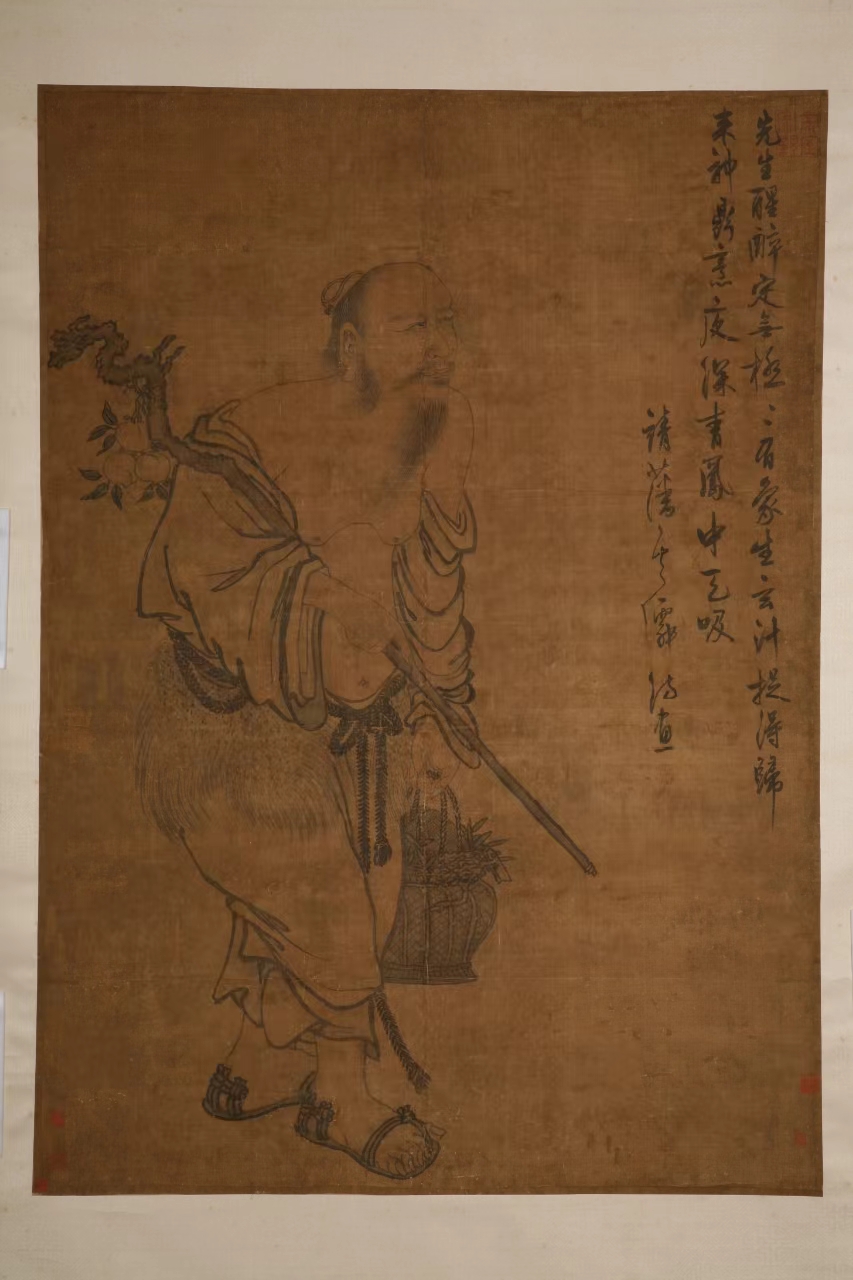
"Scroll of Immortal Collecting Herbs" by Zhu Yueji of Ming Dynasty, collected by China Three Gorges Museum, Chongqing
Zhu Yueji, a member of the Ming Dynasty clan, was named Yunxian and a native of Nongwanshan. A descendant of Zhu Shouqian, King of Jingjiang from the Ming Dynasty clan, he specialized in cultivation. He is good at poetry, calligraphy and painting, and his painting style is close to Zhang Lu. There is "Guanhua Collection", all the poems written discuss the purpose of inner elixir.
In the picture, an immortal holds a staff and carries a basket. There are medicines in the basket and fruits on the staff. His eyes are like a torch, his long beard is flowing, his clothes are wide open, he is free and unrestrained. The ink lines are mainly used to outline the figure's figure and the direction of the clothes. The ink strokes are natural and free, with a tendency to complete the work in one go. Herbs and peaches are slightly colored, which makes the ink painting brighter and highlights the elegance and simplicity of the work.
The inscription and postscript in the painting read: "Mr. wakes up drunk and determines Wuji, Wuji has the image to determine the mysterious plan. When he comes back, he cooks in the divine cauldron, sucking the green phoenix in the sky in the middle of the night." The inscription is a poem and painting by Jingfan Yunxian. There are "Emperor's Clan" seal with Zhu Wen square seal, "Jingjiang Immortal Official" with white text round seal, and "Yunquan Seal" with Zhu Wen square seal.
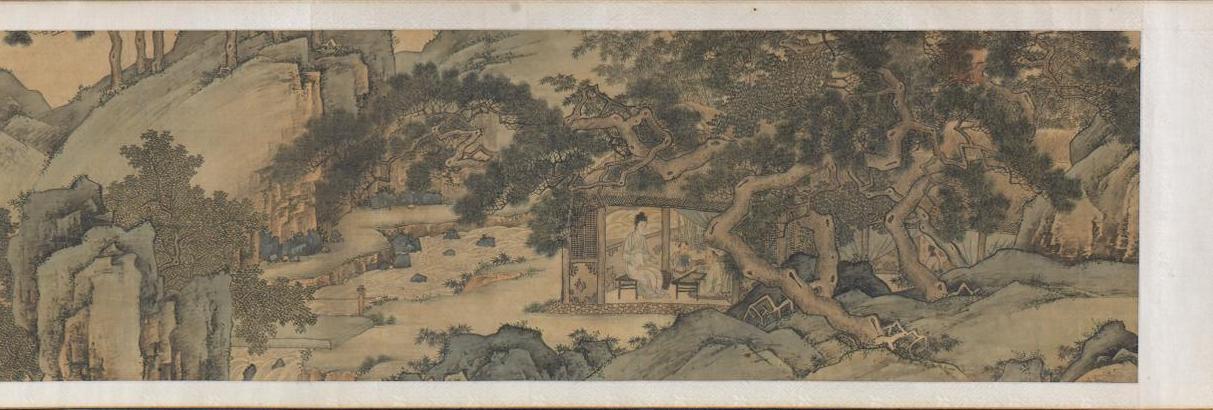
"Pihu Picture Scroll" collected by Zhouchen of Ming Dynasty, Tianjin Museum (partial part)

"Pihu Picture Scroll" collected by Zhouchen of Ming Dynasty, Tianjin Museum (partial part)
The year of birth and death of Zhou Chen is unknown. He was active between Chenghua and Jiajing of the Ming Dynasty. His courtesy name was Shunqing and his alias was Dongcun. He was a native of Wu (now Suzhou, Jiangsu). Famous professional painters in the mid-Ming Dynasty, Tang Yin and Qiu Ying both came from his sect. They were good at painting figures and landscapes, and their painting methods were rigorous and meticulous, mainly based on the methods of the Li and Tang factions.
Pihu: [bì lú]. It means Ji Ma and Lian Ma. It's called treating hemp. Ji Ma means: twist hemp into thread. China's hemp textile has a longer history than silk. The earliest textiles used by the ancients were hemp rope and linen cloth. Hemp cloth and ramie cloth have always been used as bulk clothing materials. From the Song Dynasty to the Ming Dynasty, they were gradually replaced by cotton cloth.
Unit 2 "Let the misty rain cover your life for the rest of your life"

"Taoyuan Picture Scroll" Song Xu, Ming Dynasty, collected by China Three Gorges Museum, Chongqing (detail)
Song Xu (1525-1606), whose courtesy name was Chuyang, was also known as Shimen, and later became a monk. His religious name was Zuxuan, and he was also known as Tianchi Faseng. A native of Jiaxing (formerly known as Huzhou), Zhejiang, he lives in Songjiang. Works on landscapes and figures. He studied painting under Shen Zhou and was capable of large-scale paintings and vigorous brushwork. He was known as the "Susong School" in the world and was a tributary of the Wumen School.
More than 1,600 years ago, Tao Yuanming's "Peach Blossom Spring" was published, depicting a harmonious society of calm, peace, freedom and equality. Thus, "Peach Blossom Spring" entered the hearts of thousands of Chinese people from Tao Yuanming's writings.
The painter reproduces the beauty of Taoyuan with narrative plots or single scenes. Peach trees and flowing water are irreplaceable visual elements in the painting. The secular customs of the village are put into an ideal world of seclusion, full of poetic expression.
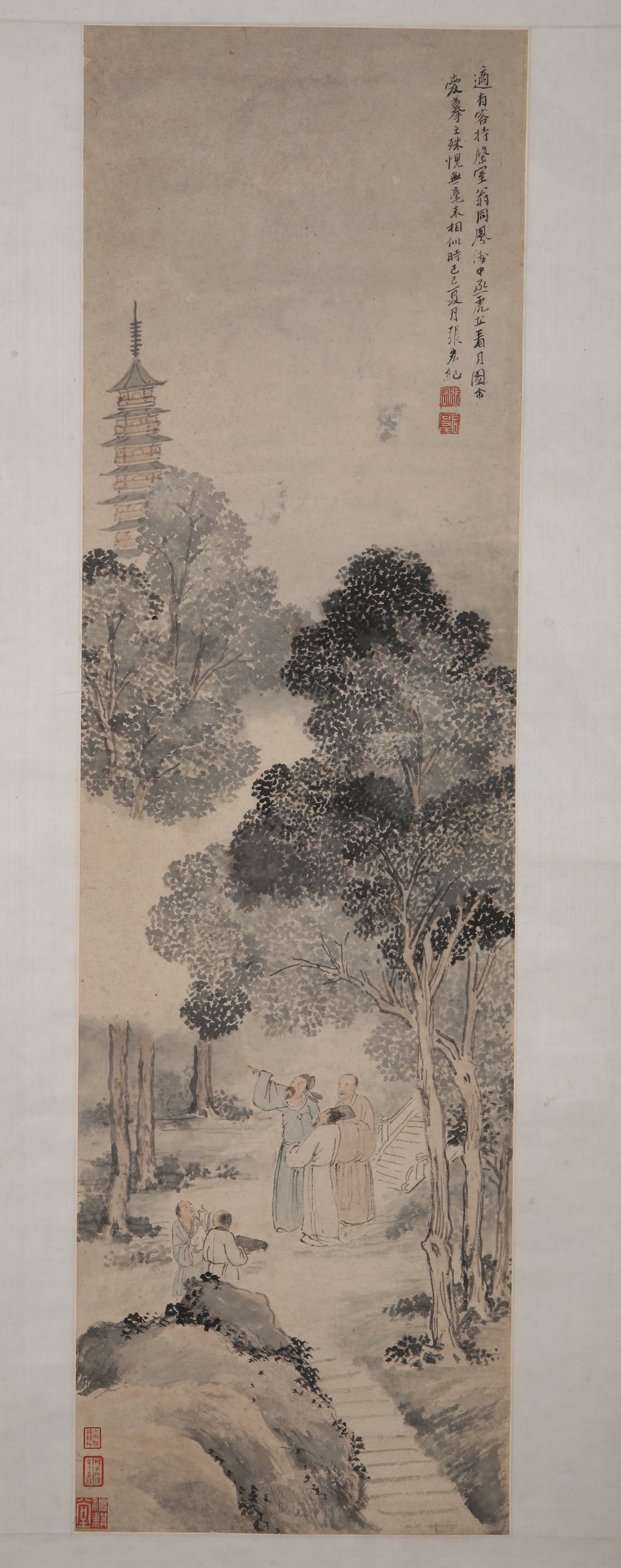
"Viewing the Moon on Tiger Hill" by Zhang Hong, Ming Dynasty, collected by China Three Gorges Museum, Chongqing
Zhang Hong (1577-1652) Yu Jundu, also known as Hedong, was born in Wuxian County (now Suzhou, Jiangsu Province) and was a master of painting in the Ming Dynasty. He is good at painting landscapes and attaches great importance to sketching. His penmanship is steep, the ink is moist, the mountains are overlapping, the autumn ravines are deep, and they have the ancient meaning of the Yuan Dynasty. His painting of stone surfaces is characterized by the combination of chapped and dyed. The freehand figures he painted are both beautiful in form and spirit, and dispersed and gathered appropriately. He was a backbone figure in the Wumen painting circle in the late Ming Dynasty, and was respected by Wuzhong scholars.
The inscription and postscript on the right side of the picture says: "There happened to be a guest with an empty house and the Prime Minister Huqiu in Fengzhou looking at the moon picture. I copied it, and I regret that it is not the same at all. It was already summer." From the inscription, we can know who were the three people looking at the moon under the tree. Among them are the Ming Dynasty Wumen calligrapher and painter Qian Gu (Qingshi) and the famous writer Wang Shizhen (Fengzhou). This work is a copy of Zhang Hong.
Shen Mingchen, a poet of the Ming Dynasty, wrote in a poem: "Where is the best place to watch the moon during the Mid-Autumn Festival, except for the Ten Continents and the Three Islands. When it comes to Suzhou in the southeast, the best place is Tiger Hill." During the Ming and Qing Dynasties, Suzhou people had the idea of "Wuzhong" on the Mid-Autumn Night. The habit of admiring the moon at Huqiu Mountain, the first scenic spot.

"Songan Reading Picture" Qing Shitao Collection of China Three Gorges Museum, Chongqing
Shi Tao, a Qing Dynasty painter and a master of Chinese painting. The name of the Dharma is Yuanji, and the first name is Yuanji. His real surname is Zhu, his given name is Ruoji, and his courtesy name is Shitao. He is also known as Balsam Pear Monk, Dadizi, Qingxiang Chenren, etc. A native of Quanzhou, Guangxi, he settled in Yangzhou in his later years. A descendant of King Jingjiang of the Ming Dynasty, he became a monk after being changed in his childhood. He traveled around for half his life and made a living selling paintings.
Inscription: "Remembering the reading place of Song'an in the distance, I put my pen straight to explore the crane and Zhu. I called the person in the picture at that time, and I missed the two years of love in the same Japanese language. On the fifth day before the spring equinox in the second month of Renwu, I sent a letter to Song'an Taoist brother to preach, written by Da Dizi of Xiang in the Qing Dynasty Qingliancao Pavilion in Hanshang."
Seal: "Qingxiang Old Man" Zhu Wenyin, "Gao Mingzi Di" Zhu Wenyin
White clouds, waterfalls, and pavilions are interspersed among the mountains and trees. A person is reading by the window in Shanwu Thatched Cottage. Mountains and waterfronts have always been the first choice for literati to study quietly and cultivate themselves. Shi Tao said in his "Bitter Melon Monk's Painting Quotations": "Mountains and rivers represent mountains and rivers - mountains and rivers are transformed into traces when God encounters them." Shi Tao blended his spiritual feelings with the natural scenes and imagined himself Can become the spokesperson of mountains and rivers.
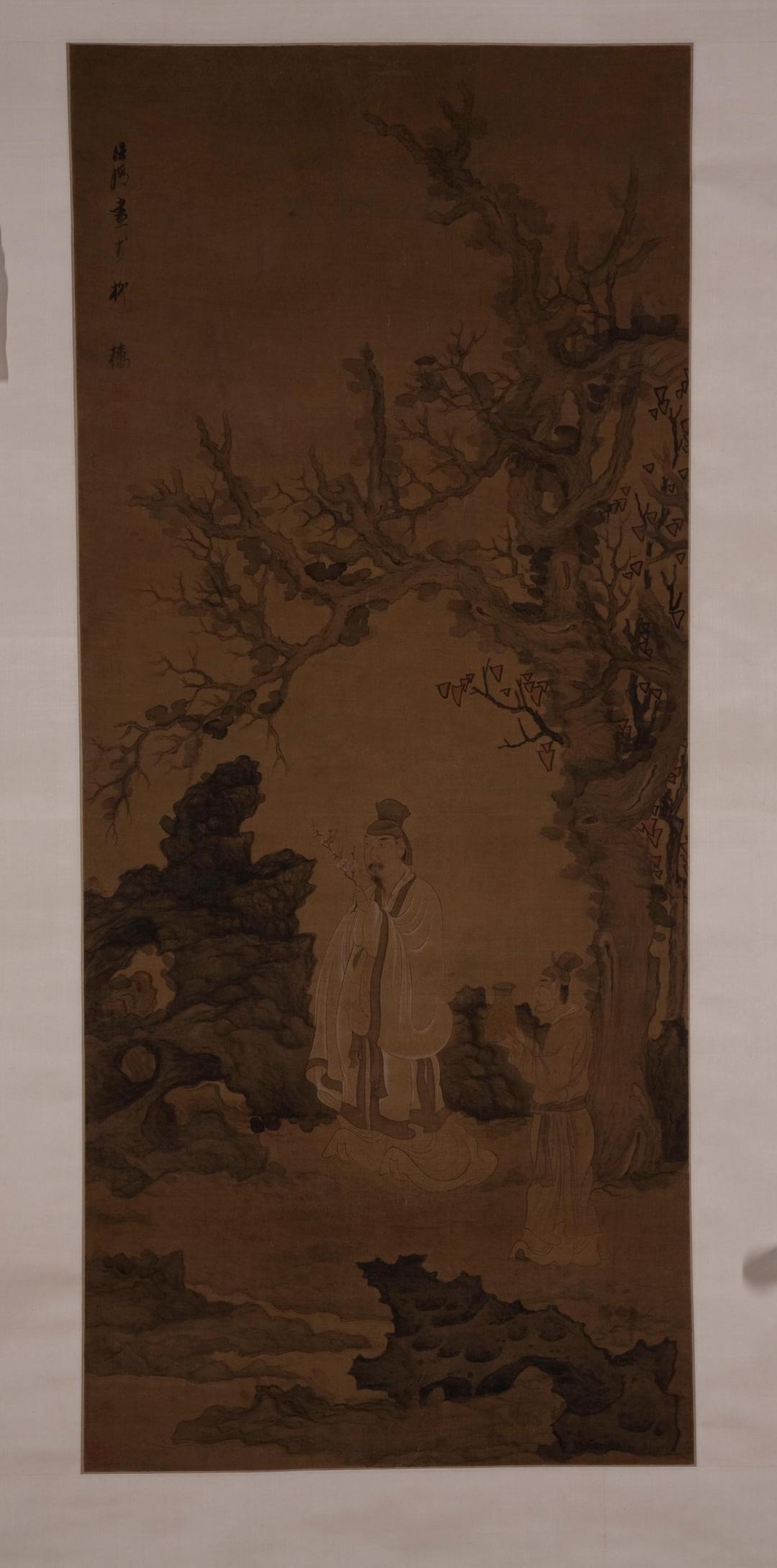
"Scroll of Plum Blossom Picking" by Chen Hongshou, Ming Dynasty, collected by Tianjin Museum
Chen Hongshou (1598-1652), named Zhanghou, also known as Laolian, Hui Chi, Hui Seng, Chi Monk, etc., was a native of Zhuji, Zhejiang. In his early years, he studied under Liu Zongzhou and Huang Daozhou, and also studied painting from Lan Ying and Sun Qi. He is good at poetry and prose, and is good at figures, flowers and birds, and landscapes. His painting style can be traced back to the Jin and Tang Dynasties, and he also inherits the methods of the Song Dynasty. He is good at various themes. He can paint figures, landscapes, flowers and birds, and combines ancient and modern times. He has his own style and does not follow the conventional changes. , the characters are slightly exaggerated, the landscape paintings have decorative interest, and the flowers and birds are strong and hard. Together with Cui Zizhong, they are called "Southern Chen and Northern Cui". It had a profound influence on later generations of figure paintings.
Chen Hongshou loves plum blossoms, chants plum blossoms, draws plum blossoms, and appreciates plum blossoms. When painting plum blossoms, one must seek the ancient meaning and the shape must be curved. I believe that if it is not curved or curved, it will not be ancient, and if it is not ancient, it will have no rhyme.
Plum blossoms are a symbol of noble character and are often used as a metaphor for the psychological appeal of "rebirth". Chen Laolian was extremely talented, but she experienced several failed imperial examinations in her life, her country was ruined, her family was ruined, and she was in poverty. In September of the year when the Ming Dynasty fell, he wrote in a poem: "The two kings do not persuade me to become an official. If I become an official, I will suffer. A few drops of fallen plum blossoms float green wine, and a pair of drunk eyes look at the green mountains." The joy of his life lies in it. This poem shows everything at a glance.

"Linxie Jiancha Picture Scroll" Mingwen Zhengming Collection of Tianjin Museum
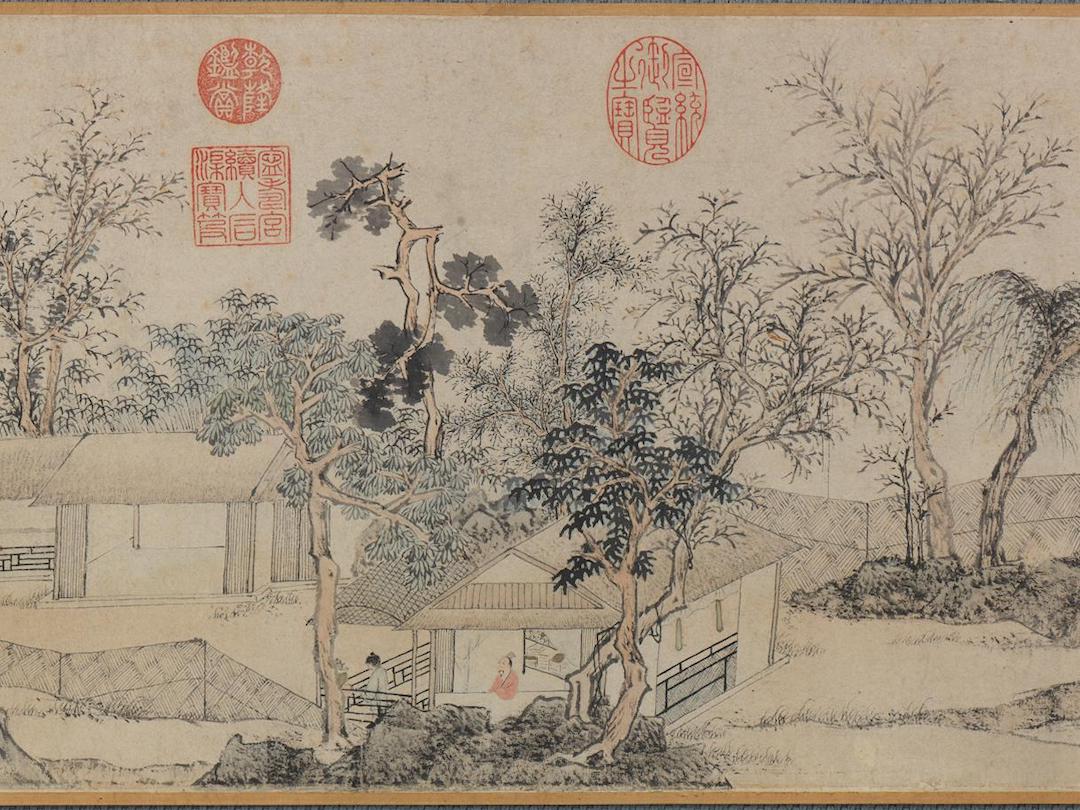
"Linxie Jiancha Picture Scroll" Mingwen Zhengming Collection of Tianjin Museum
Wen Yuming (1470-1559) was an outstanding painter of the Ming Dynasty. The name is Bi, and the courtesy name is Yu Ming, followed by the character Xing. A native of Changzhou (now Suzhou, Jiangsu). Poetry, writing, and painting are all excellent. Known as the "Four Wonders", he is an all-rounder who specializes in landscapes, figures, flowers, orchids and bamboos. Together with Tang Yin, Shen Zhou and Qiu Ying, he is known as the "Four Masters of the Ming Dynasty".
This picture was made by Wen Zhengming for Wang Huxiang. In the elegant and tranquil countryside, there is no noise, no hustle and bustle, quiet and leisurely. The servant cooks tea, the master leans on the railing, and friends come to visit on the mountain path outside the courtyard. This scroll has elegant colors, fine and green brushwork, calmness and quietness, and rigorous and meticulous composition. It is deeply loved by the royal family.
There are many imperial collection seals on the scroll: "Shiqu Baoji" in Zhuwen, "Shiqu Dingjian" in Zhuwen, "Baoji Reedited" in white, "Le Shoutang Appraisal of Treasures" in white, and "Qianlong Imperial Treasure". "Zhu Wen Yin, "Treasure of Jiaqing Imperial View" Zhu Wen Yin, "Qianlong Appreciation" Bai Wen Yin, "Treasure of Xuantong Yu Lan" Zhu Wen Yin, "Ningshou Palace Continuing to Enter Shiqu Baoji" Zhu Wen Yin, "Sanxi Hall Jingjian Seal" "Zhu Wenyin, "Yi Zisun" Bai Wenyin.

"Scroll of Sleeping Travel" by Luo Mu, Qing Dynasty, collected by China Three Gorges Museum, Chongqing
Luo Mu, a painter of the Qing Dynasty, had the courtesy name Fanniu and his nicknames were Yun'an, Muxingzhe, and Zhuxi. A native of Diaofeng, Ningdu County, Jiangxi Province, he lives in Nanchang. He is good at landscapes and has an ethereal brushwork. He was taught by Wei Shitang between Huang Gongwang and Dong Qichang. He was the founder of the Jiangxi School and was a disciple of many people in the Jiang and Huai areas.
In the Southern Dynasty, Zong Bing painted the mountains and rivers he visited in his life on the wall. When he looked at them every day, he felt as if he was swimming among the mountains and rivers again, thus achieving the purpose of "sleeping the mind". The theory of "wandering" has deeply influenced the Chinese painting world. Therefore, literati used the imagery of landscapes to illuminate the essence of personal life with the vastness of nature, the high mountains and the clear water.
The author's postscript reads: "I live in seclusion close to the stone spring, and the cold clouds on the blue wall hide the faint emerald green. I want to write this idea, but I will never forget to return home when I lie down and travel for the rest of my life." It should be the presentation of the idea of "lying and wandering".
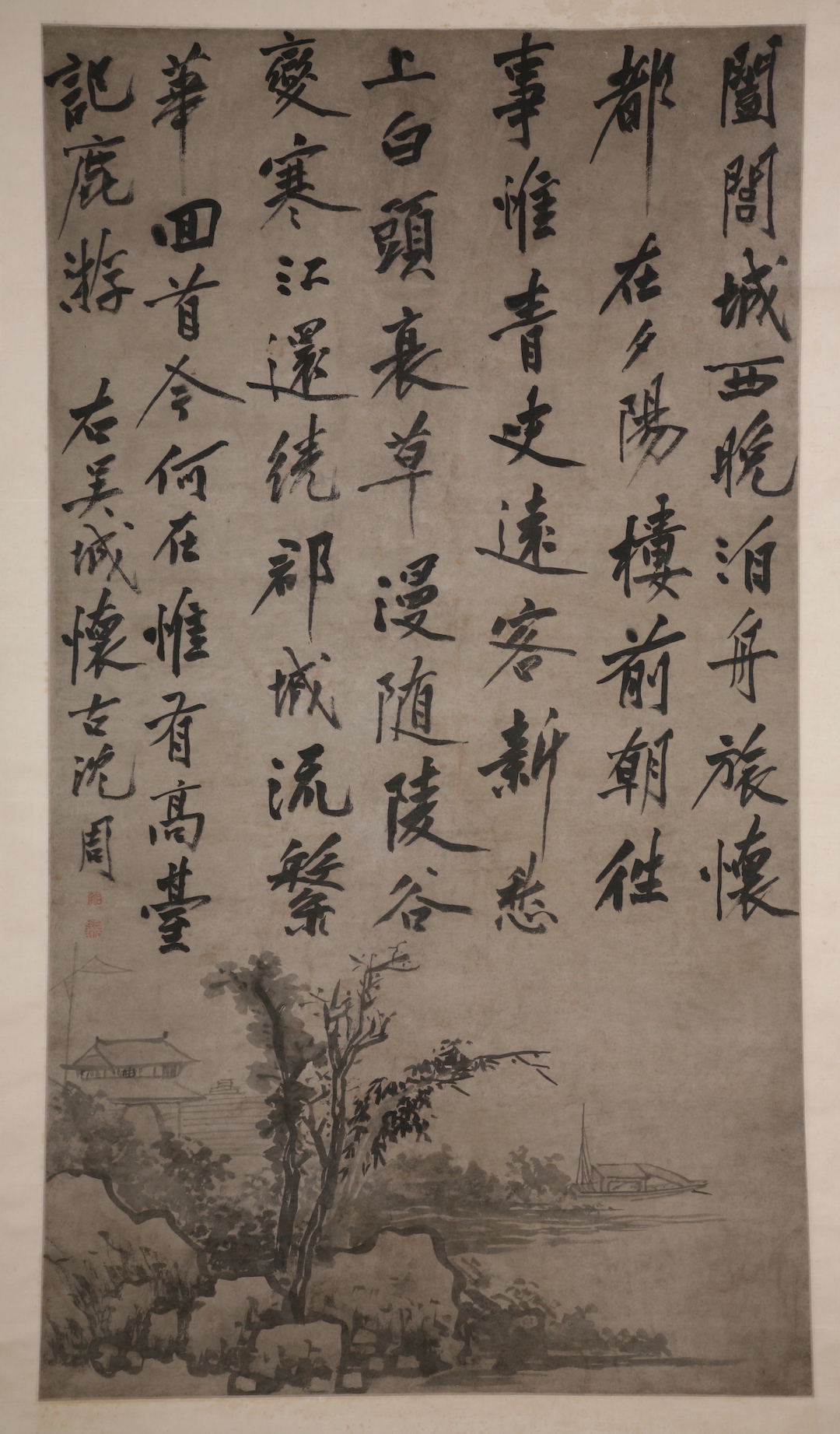
"Wucheng Nostalgic Scroll" by Shen Zhou, Ming Dynasty, collected by China Three Gorges Museum, Chongqing
Shen Zhou (1427-1509), whose courtesy name was Qinan and whose name was Shitian, called himself Shitian Weng. A native of Changzhou (now Suzhou, Jiangsu). It can be used to describe landscapes, flowers, birds, and figures. The style of writing has gone from the Song Dynasty to the Yuan Dynasty, showing a spicy and delicate appearance. There were many followers at that time. Together with Wen Yuming, Tang Yin and Qiu Ying, they formed the "Four Wu Clan".
The work is unique and uses large-scale calligraphy as the theme, with landscapes and towers at the bottom. Although it is not as open as distant mountains and tall buildings, the majestic style of calligraphy gives the painting a majestic momentum.
The poem in the picture reads: "The boats are parked in the west of Helv City at night, and all the travelers are in the Sunset Tower. The past events of the previous dynasties are just history, and the new sorrows of distant visitors are old. The decaying grass is changing with the mausoleum valley, and the cold river still flows around the county and city, which is prosperous. Looking back, where are we now? Only Gaotai records the deer's journey."

"Songyin Gaoshi's Scroll" by Cheng Jiasui, Ming Dynasty, collected by China Three Gorges Museum, Chongqing
Cheng Jiasui (1565-1643), whose courtesy name was Meng Yang, also had the nicknames Songyuan and Gaian. In his later years, he converted to Buddhism and was named Hai Neng. A native of Xiuning County, Huizhou Prefecture (now Xiuning, Anhui Province), Nanzhili Province. He is good at poetry and landscape painting, learning from Huang Gongwang and Ni Zan. His pen and ink are dry and light, but his rhyme and style are both excellent.
"Gaoyi" refers to a person who is elegant, free and uninhibited, or a person who lives in seclusion. In Chinese paintings, it is common to see elegant people walking in the mountains or boating on the lake, looking for a spiritual solace of freedom and tranquility.

"Guanshan Travel Picture Scroll" Xiao Yuncong, Ming Dynasty, collected by China Three Gorges Museum, Chongqing

"Guanshan Travel Picture Scroll" Xiao Yuncong, Ming Dynasty, collected by China Three Gorges Museum, Chongqing

"Guanshan Travel Picture Scroll" Xiao Yuncong, Ming Dynasty, collected by China Three Gorges Museum, Chongqing

"Guanshan Travel Picture Scroll" Xiao Yuncong, Ming Dynasty, collected by China Three Gorges Museum, Chongqing

"Guanshan Travel Picture Scroll" Xiao Yuncong, Ming Dynasty, collected by China Three Gorges Museum, Chongqing
Xiao Yuncong (1596-1673), also known as Chimu, also known as Mosi, Wumen Taoist, Zhongshan Laoren, etc., was born in Wuhu, Anhui. Proficient in six books and six rhythms, poetry and prose, good at painting landscapes, and good at figures and flowers. He joined the Fushe in the 11th year of Chongzhen in the Ming Dynasty (1638) and fought against the eunuch group. After entering the Qing Dynasty, he lived in seclusion and did not serve as an official. His figure paintings mainly inherited the line drawing method of Li Gonglin of the Song Dynasty, and also absorbed the strengths of Chen Hongshou of the Ming Dynasty, with accurate shapes and vivid images. His landscape paintings are unique in their own way, with clear and sparse brushwork and elegant colors. His paintings had a great influence in his hometown of Wuhu, forming the "Gushu Painting School".
Inscription: "I have tried to make travel pictures in Guanshan. I have not prepared any pictures of people, boats and carriages, gardens, and shopping malls. I can't get enough of them. I sometimes imitate them, and I can't tell the authenticity. Then all the Lanting books were lost, and I didn't expect to see the original traces again." . Then I was as happy as if I met an old friend and urgently saved it. I should earn it for my family's censor. Xiao Congyun, a seventy-year-old man, knows it."
Seal: Zhu Wen "Zhongshan Old Man" seal.

"Yunshan Xiaoyin Picture Scroll" Dong Qichang, Ming Dynasty, collected by China Three Gorges Museum, Chongqing

"Yunshan Xiaoyin Picture Scroll" Dong Qichang, Ming Dynasty, collected by China Three Gorges Museum, Chongqing

"Yunshan Xiaoyin Picture Scroll" Dong Qichang, Ming Dynasty, collected by China Three Gorges Museum, Chongqing
Dong Qichang (1555-1636), whose courtesy name was Xuanzai, also known as Sibai, and Xiangguang Jushi, was a native of Huating (now Songjiang, Shanghai). In the 16th year of Wanli in the Ming Dynasty (1588), he became a Jinshi and became the Minister of Rites. He died with the posthumous title Wenmin.
This volume uses ink to describe the summer landscapes of the south of the Yangtze River. The mountains and rocks are scratched with thirsty brushes, and the forest trees are dotted with wet ink to show the lushness of the trees in summer. The open spaces between the hills and valleys add to the sparse and distant feeling of the painting.
Unit 3 "How many changes have occurred in personnel and affairs over the past century"











"Wanhu Chaotian Picture Scroll" Qing Dynasty Anonymous Collection of Tianjin Museum
"The Picture of Wanhu Chaotian" was carefully painted by Fan Yao, a descendant of Fan Zhongyan, to commemorate Qianlong's six visits to Jiangnan and his four visits to Mount Tianping. This painting is splendid and magnificent, with more than 2,000 figures alone. It reproduces the mountains and rivers, the market customs and the grand welcome scene in the western area of Suzhou during Qianlong's southern tour. The picture is centered on Tianping Mountain and connects famous ancient temples in Zhijie Mountain and Lingyan Mountain. Famous scenic spots in the Tianping Mountain Scenic Area such as Gaoyi Garden and Baiyun Spring are clearly visible, and the nearby rivers, causeways, terraces and pavilions, trees and fields, boat and boat bridges, archways and shops, as well as pedestrians, officials, traders, farmers, etc. The carvings are very detailed and lifelike.

"Han Xizai's Night Banquet", Yin, Tang Dynasty, Collection of China Three Gorges Museum, Chongqing (detail)

"Han Xizai's Night Banquet", Yin, Tang Dynasty, Collection of China Three Gorges Museum, Chongqing (detail)

"Han Xizai's Night Banquet", Yin, Tang Dynasty, Collection of China Three Gorges Museum, Chongqing (detail)
Tang Yin (1470-1523), whose courtesy name was Bohu, also known as Ziwei, and whose nickname was Liuru Jushi, the master of Taohua Nunnery, Tang Sheng of Lu State, the immortal official of Fleeing Zen, etc., was a Han nationality and a native of Wuxian County, Suzhou, South Zhili. A famous painter and writer in the Ming Dynasty. It is said that he was born in Yin month, Yin day and Yin time, Gengyin year, the sixth year of Chenghua reign of Emperor Xianzong of Ming Dynasty. He was cynical and talented, and was good at famous poems and essays. Together with Zhu Yunming, Wen Zhengming, and Xu Zhenqing, he was known as one of the "Four Great Talents in the South of the Yangtze River (Four Talents of the Wu Clan)". "Four families".
"Han Xizai's Night Banquet" is a famous painting collected by the Palace Museum. It was originally painted by Gu Hongzhong during the Five Dynasties period and is now a copy of the Song Dynasty. This painting details the family banquets of the upper class during the Five Dynasties and Ten Kingdoms period and the Southern Tang Dynasty. The "Han Xizai Night Banquet" exhibited at the China Three Gorges Museum in Chongqing was copied by Tang Yin of the Ming Dynasty. Tang Yin re-created it during the copying. The painting incorporates the decorative layout of garden room art and the Wumen style of literati in the Suzhou area of the Ming Dynasty. The landscape art style of the school of painting.
Poem: "When I am in the hook department and I am short of fish soup, I will lend a water balance to the long-term laborer. I spend a lot of money to collect the pink powder, how can I not learn from Mr. Geng? Tang Yin of the Wu family."
Seals: "Mengmo Pavilion" Zhu Wenyin, "Tang Bohu" Zhu Wenyin, "Nanjing Jieyuan" Zhu Wenyin.
Poem: "The temples are combed into crows to perform new songs, and the courtyards are lit with lanterns to embrace the green goddess. Who can match the natural and unrestrained mood? Zheng Yuanhe in the wind and snow of Baqiao. Tang Yin in Wujun."
Seals: "Wu Jun" Zhu Wen Yin, "Tang Yin Private Seal" Bai Wen Yin, "Liuru Jushi" Zhu Wen Yin.
Appraisal seals: "Li Shi Shou Xuan" Zhu Wen Yin, "Li Xianzhong" Bai Wen Yin, "Qingbai Prefect's Son" Zhu Wen Yin, "Huazhu Qin Shu Delightful Things" Zhu Wen Yin, etc.

"Han Xizai's Night Banquet" by Yin Tang, Ming Dynasty, collected by China Three Gorges Museum, Chongqing

exhibition poster
The exhibition lasts until May 20.
(The graphic and text appreciation materials of this article are all provided by the organizer)
